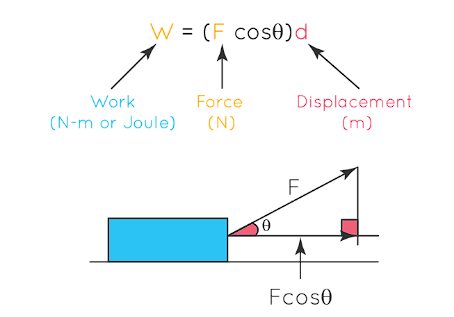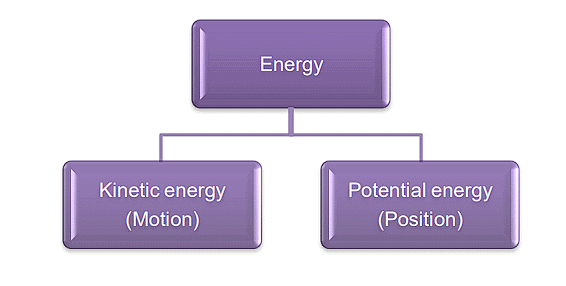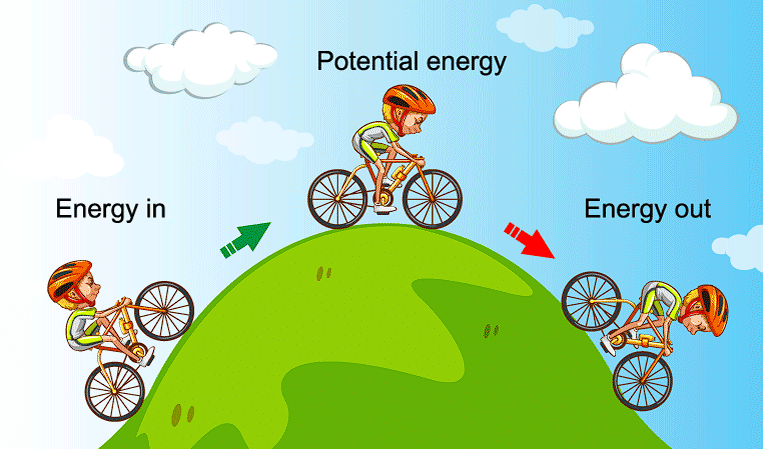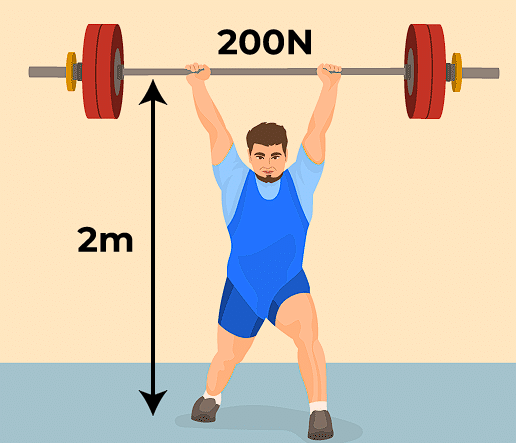Work and Energy Class 9 Notes Science Chapter 10
| Table of contents |

|
| What is Work? |

|
| What is Energy |

|
| Law of Conservation of Energy |

|
| What is Power? |

|
All living things need food for energy to survive and do activities like playing or running. Animals also use energy for tasks like hunting or defending themselves. Machines, like cars or tools, need specific resources to work, such as fuel. Just like living beings, machines need energy to function properly.
What is Work?
Work is done when a force produces motion in a body. Work is the product of the force applied and displacement in the direction of the force applied.
- Work= Force x Distance
- Work is a scalar quantity. It has only magnitude and no direction.
- Its SI unit is joule (J).
- One joule of work is said to be done on an object when a force of 1 N displaces the object by 1 m
along the line of action of force.

Work done by a force can be positive, negative or zero.
(a) It is positive when a force acts in the direction of motion of the body.
- (Case I)
If displacement is in the direction of the force
W = F × s
(b) It is negative when a force acts opposite to the direction of motion of the body.
- (Case II)
If displacement is in the direction opposite to the force
W = − F × s
(c) It is zero when a force acts at right angles to the direction of motion of the body.
- (Case III)
If displacement is perpendicular to the force, work done is zero.
What is Energy
Energy as the ability to do work.
- The amount of energy possessed by a body is the amount of work it can do when that energy is released.
- Energy is a scalar quantity.
- Its SI unit is joule (J). 1 kJ = 1000 J
- The main forms of energy are kinetic energy, potential energy, chemical energy, heat energy, light energy, sound energy, electrical energy and nuclear energy.

(a) Kinetic Energy
Energy possessed by a body due to its motion. Kinetic energy of an object increases with its speed. Kinetic energy of body moving with a certain velocity = work done on it to make it acquire that velocity.Derivation
Let an object of mass m, moves with uniform velocity u, let us displace it by s, due to constant force F, acting on it
∴ Work done → W = F × s ... (i)
due to force the velocity changes to v, and the acceleration produced is a
∴ Relationship between v, u, a and s : v2 − u2 = 2as
∴ ... (ii) and
F = ma ... (iii)
Substitute (ii) and (iii) in (i), we get W = F × s
if u = 0, (object starts at rest)
∴ W = (1/2) mv2
Work done = Change in kinetic energy
∴ Ek = (1/2)mv2
(b) Potential Energy
The energy possessed by a body due to its position or shape is called its potential energy.- Gravitational Potential Energy: (GPE) When an object is raised through a height, work is said to be done on it against gravity.
The energy possessed by such an object is called the gravitational potential energy.
∴ GPE = work done in raising a body from the ground to a point against gravity. - Derivation
Consider a body with mass m, raised through a height h, from the ground, Force required to raise the object = weight of object mg.
Object gains energy equal to the work done on it.
∴ Work done on the object against gravity is W.
∴ W = force × displacement = mg × h
W = mgh
∴ PE = mgh
Work done in both the cases (i) and (ii) is same as a body is raised from position A to B, even if the path taken is different but the height attained is the same. - Mechanical Energy: The sum of kinetic energy and potential energy is called mechanical energy.
Note: Energy can neither be created nor destroyed, it can only be transformed from one form to another. The total energy before and after transformation remains the same.
Case (i)
Potential energy + Kinetic energy = Constant (Mechanical energy)
A body of mass ‘m’ is raised to height ‘h’ at A its potential energy is maximum and kinetic energy is 0 as it is stationary.
When body falls at B, h is decreasing hence potential energy decreases and ‘v’ is increasing hence kinetic energy is increasing.
When the body is about to reach the ground level, h = 0, v will be maximum hence kinetic energy > potential energy
∴ Decrease in potential energy = Increase in kinetic energy
This shows the continual transformation of gravitational potential energy into kinetic energy.
Law of Conservation of Energy
Law of Conservation of Energy is the most fundamental law of physics which states that “Energy can neither be created nor be destroyed it can only change from one form of the energy to another form of the energy.” It is the fundamental law of Physics that governs various processes in our environment.
Example: The law of conservation of energy can easily be understood by the following example, here in the image given below the total energy of the cyclist at the bottom of the hill is in the form of Kinetic Energy only, and at the top of the hill is in form of potential energy.

What is Power?
Power is a measure of how quickly work is done or energy is transferred.

- The unit for power is the watt, named after James Watt. One watt means you're doing one joule of work every second, like turning on a small light bulb

- . For larger amounts of power, we use kilowatts, where one kilowatt equals 1000 watts, similar to a small heater's power.
- Sometimes power changes over time, so we use average power to see the overall rate at which energy is used or work is done.
- Average power by dividing the total energy used by the total time taken.
|
85 videos|548 docs|60 tests
|
FAQs on Work and Energy Class 9 Notes Science Chapter 10
| 1. What is the definition of work in physics? |  |
| 2. How is work calculated? |  |
| 3. What is the unit of work in the metric system? |  |
| 4. How is energy related to work? |  |
| 5. What is the difference between work and power? |  |
















